Flexible & Printed Electronics Market Size
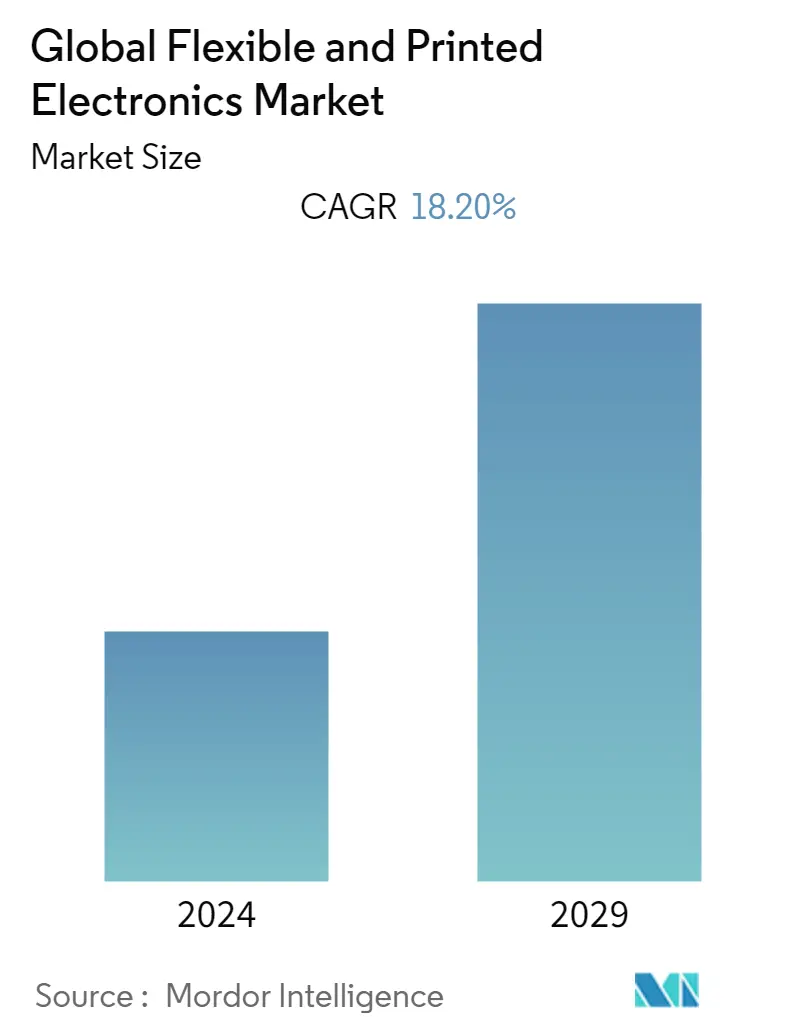
| Study Period | 2019 - 2029 |
| Base Year For Estimation | 2023 |
| CAGR | 18.20 % |
| Fastest Growing Market | North America |
| Largest Market | Asia-Pacific |
| Market Concentration | Medium |
Major Players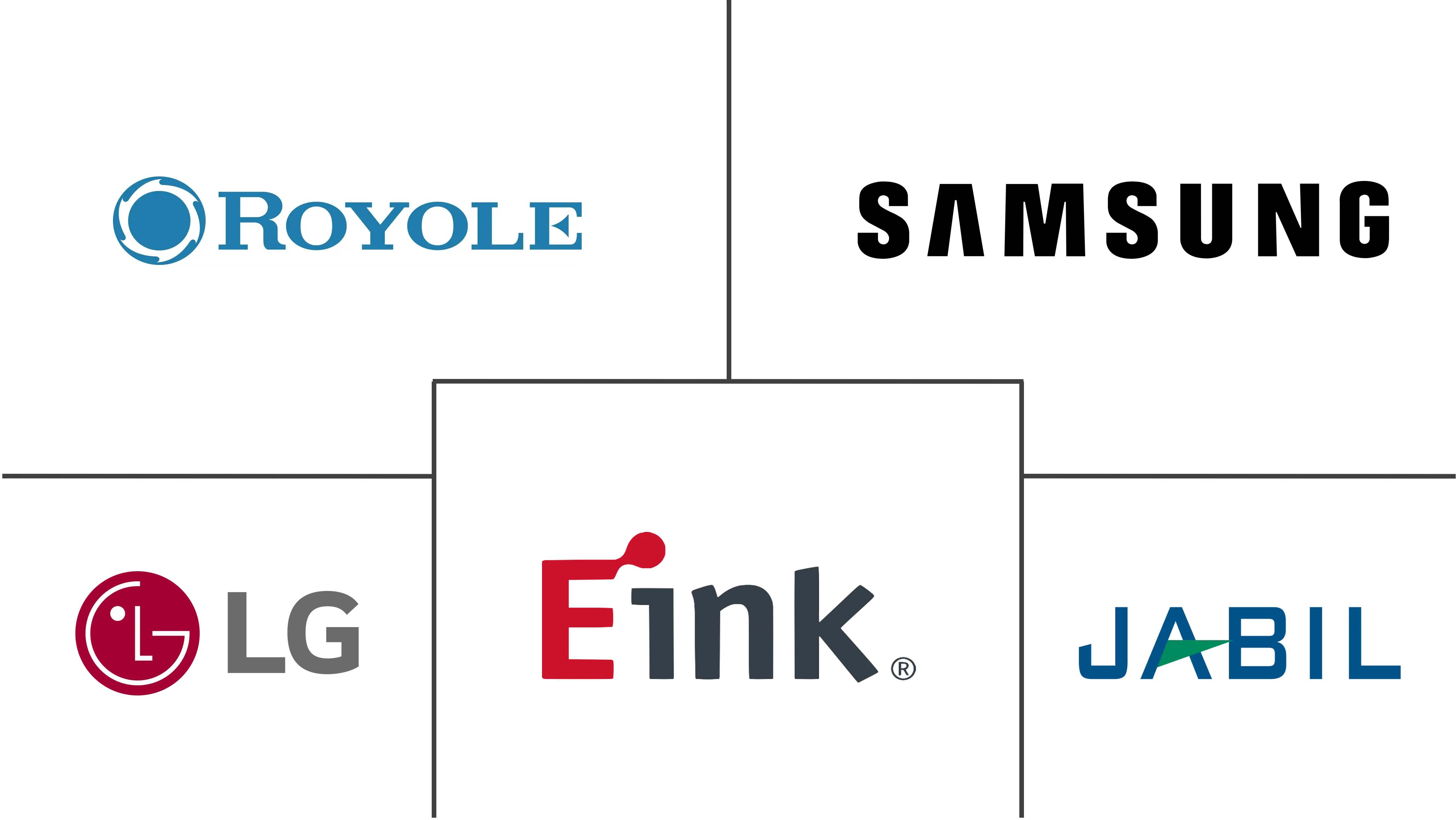
*Disclaimer: Major Players sorted in no particular order |
Flexible & Printed Electronics Market Analysis
The global Flexible and Printed Electronics Market is expected to register a CAGR of 18.2% during 2022-2027. The market is primarily driven by the rapid penetration of smart wearable and integrated electronic devices that have increased demand for advanced intelligent systems with high performance, micro size, mechanical flexibility, and high-temperature stability for use as flexible and stretchable displays, personal health monitoring, human motion capturing, smart textiles, electronic skins, and other applications.
- Electronics players in the market, such as Samsung and LG Electronics, have introduced the flexible, foldable, and rollable smartphone, display, and tablet products. Because of the rapidly aging global population and the dramatically increasing demand for in-home healthcare, wearable and mobile health monitoring technologies have recently sparked tremendous interest worldwide.
- According to BNP Media, electronic components will account for 50% of an automobile's total production cost by 2030. Earlier in the decade, it was only 30%. Thin, light, and flexible electronics advancements are driving various innovative technologies, from curved TVs to glucose-monitoring contact lenses. This could result in the development of printable solar cells and flexible screens based on organic light-emitting diodes (OLEDs).
- The electronics industry is rapidly transitioning from standard, rigid form factors to stretchable and conformable devices. Wearables for healthcare, smart packaging, sensors, automotive taillights and displays, flexible displays, photovoltaics, and other printed, flexible, and stretchable electronics products are increasing weekly.
- Furthermore, in-mold electronics (IME) and flexible sensors are expanding the application of flexible and printed electronics in smart wearable technologies. Wearable device growth, particularly smart wearable device growth, may broaden the market scope over the forecast period. Cisco predicts that the number of connected wearables will exceed 1,105 million by 2021.
- COVID-19's emergence and expansion have significantly impacted the company's position in the flexible electronics and electronics value chain. On the other hand, the market for flexible electronics has declined significantly due to global shutdowns that have resulted in the complete closure of all public places, industrial facilities, and offices.
- The COVID-19 outbreak caused major delays for electronic manufacturers, as Chinese suppliers have struggled to keep factories running at full capacity. Many electronic manufacturers in the United States and Europe rely on components manufactured in China. In February, IPC, an electronic equipment trade organization, surveyed 65% of the 150 electronic manufacturers and suppliers who participated and reported supplier delays due to the spread of COVID-19.
Flexible & Printed Electronics Market Trends
This section covers the major market trends shaping the Flexible & Printed Electronics Market according to our research experts:
The explosive growth of smart wearable devices to augment market growth
- Based on a new wave of digital materials, printed, flexible, and stretchable sensors and electronics will open up new possibilities in industries ranging from healthcare to automotive to buildings. These technologies will drive innovation in smart medical technology, automotive, smart manufacturing, the Internet of Things (IoT), and consumer electronics.
- The global flexible and electronics Printing market is being driven by using flexible batteries in wearables, electronic textiles, portable electronics, wireless sensors, and smart packaging-their ability to treat skin patches integrated with printed batteries displacing medicine. The market growth of OLED eye masks configured with printed and flexible electronics is being disrupted.
- Printed electronics provide users with photonic devices and printed electronics on various substrates; printing technologies include flexography, inkjet, gravure, and screen printing. These techniques print on substrates such as cloth, paper, and plastics. This printing method is widely used on wearable devices, in the sports industry, and for flexible screens, among other things.
- The growing acceptance of thin-film solar modules for a wide range of applications and the growing use of flexible displays for applications such as wearable devices and smartphones are all driving market growth. Furthermore, the growing use of flexible electrical parts in IoT applications, and flexible electronics in healthcare applications, are influencing the flexible electronic components market.
- Recent advancements in stimuli-responsive surfaces and interfaces, sensors and actuators, flexible electronics, nanocoatings, and conductive nanomaterials have created a new generation of smart and adaptive electronic fibers, yarns, and fabrics for use in E-textiles. In addition, Wearable low-power silicon electronics, light-emitting diodes (LEDs) on fabrics, textiles with integrated Lithium-ion batteries (LIB), and electronic devices such as smart glasses, watches, and lenses have all been widely explored and commercialized.
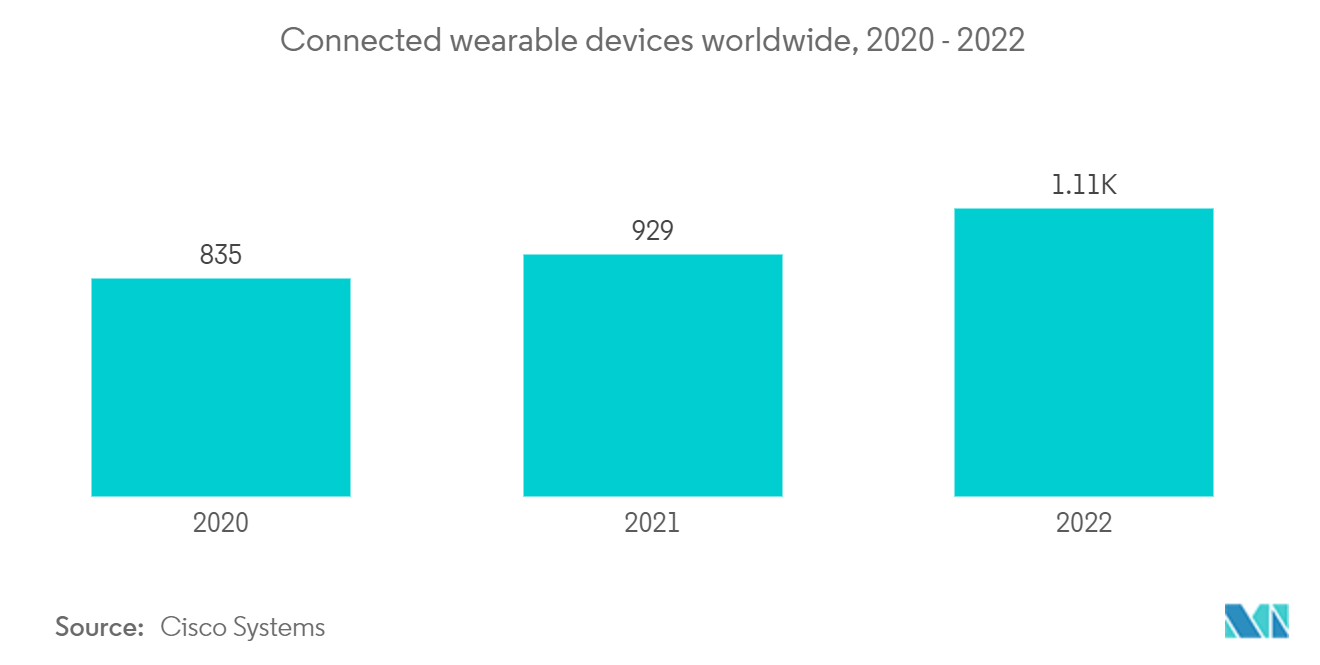
Asia-Pacific to hold considerable market share
- APAC is expected to have a considerable share of the global printed electronics market throughout the forecast period. APAC is a hub for the production of electronic devices and components. The expansion of the APAC printed electronics market can be attributed to the region's large-scale production of electronic components and increased investments in R&D activities related to printed electronics.
- Asia-Pacific printed electronics market is unique compared to the other regions because of its size and diversity. The region accounts for more than 60% of the global population, and its population has grown nearly four-fold in the 20th century alone. This rise in population is a huge advantage in terms of economic potential and aids the suppliers of the printed electronics industry.
- APAC is home to Samsung Display and LG Display, two global leaders in flexible display manufacturing and innovation. This provides the local market with indigenous production sites and low-cost prices, which increases local demand from the densely populated economies of India and China.
- The region is also one of the major automotive manufacturing regions globally. The rapid growth of advanced automotive electronics for engine control, ADAS, and future autonomous vehicle infrastructure is increasing the need for efficient solutions that lower the overall assembly cost, deliver the highest yield, and ensure reliability. There have been several noteworthy advances already. Printed heaters have long been part of cars. Additionally, OLED lighting appears on rear taillights in a few high-end Audi and BMW models. OLED lighting solutions allow designers to come up with new and creative looks.
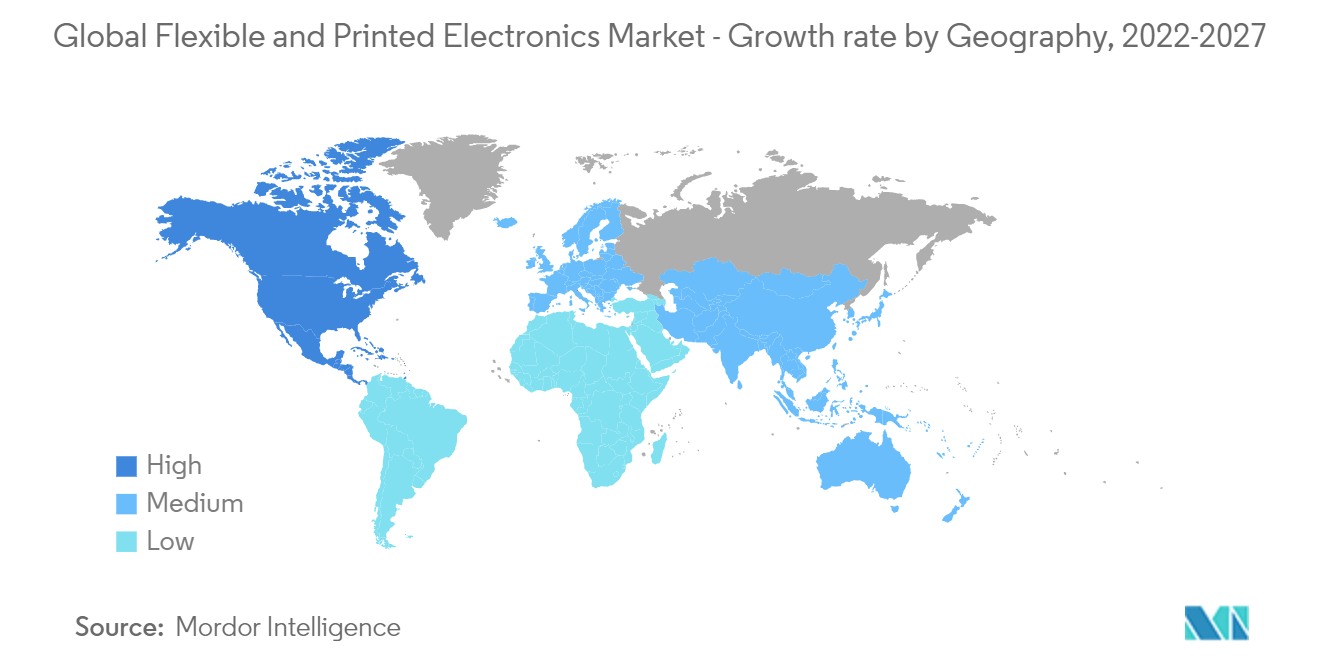
Flexible & Printed Electronics Industry Overview
In recent years, major firms and corporations have significantly impacted the market. With the increased demand for high-quality consumer electronics and products worldwide, companies are expected to invest heavily in developing novel and advanced solutions for their customers.
- February 2022 - Eaton Corporation PLC and LG Electronics collaborated to make flexible household energy management more effective and seamless. According to the agreement, Eaton smart breakers and EV charging technology will sync with LG energy management services, providing critical information and load management for solar and storage applications.
- April 2022- Carevive Systems (Carevive), a leading oncology-focused health technology company focused on understanding and improving the cancer patient experience, today announced a collaboration with Blue Spark Technologies, a leader and innovator in wearable wireless medical device solutions.
Flexible & Printed Electronics Market Leaders
-
SAMSUNG
-
LG Electronics
-
Jabil Inc.
-
Royole Corporation
-
E Ink Holdings Inc
*Disclaimer: Major Players sorted in no particular order
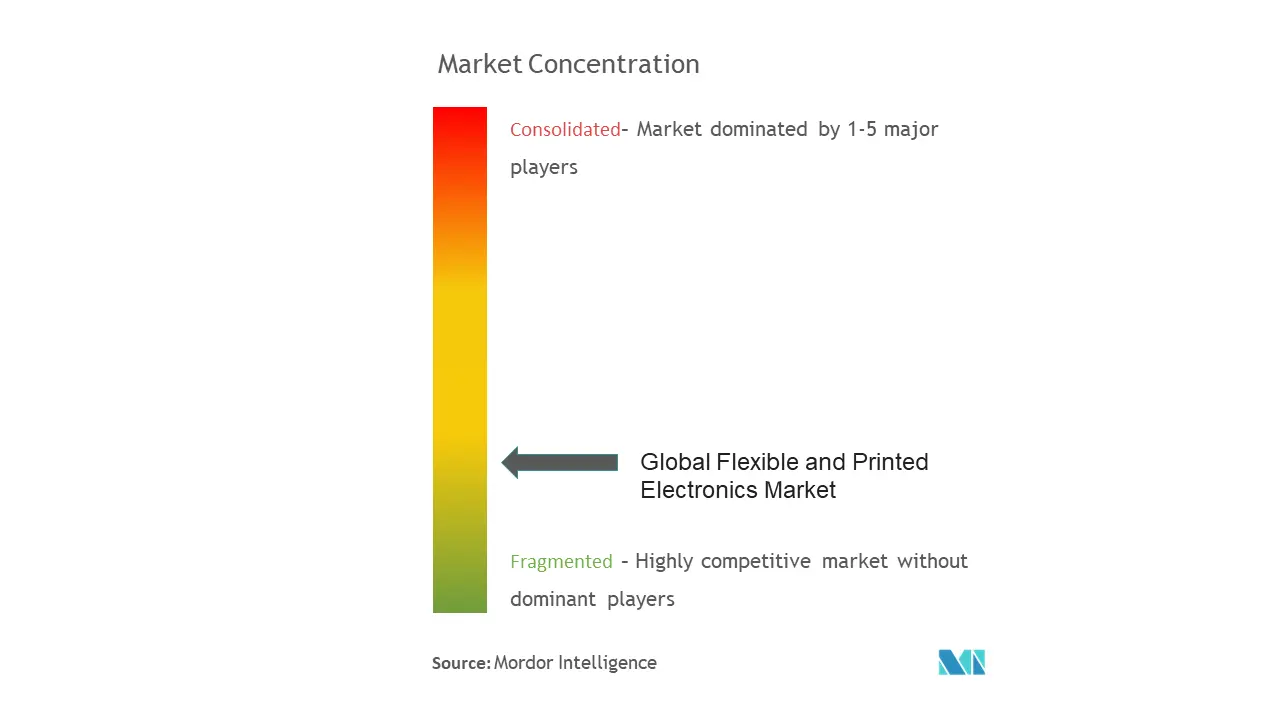
Flexible & Printed Electronics Market News
- March 2022- E Ink Holdings, the leading innovator of electronic ink technology, and Avalue, a provider of industrial PC solutions, announced a collaboration to offer the next-generation Digital Paper Tablet Solution for Business. The Digital Paper Tablet is based on the Linfiny product, a collaboration between E Ink and Sony Semiconductor Solutions.
- September 2021- LG Chemical created new technology that can be used for foldable displays by combining new material tools and coating technologies. This will assist the company in entering and expanding into the next-generation materials industry within the next few years.
Flexible & Printed Electronics Market Report - Table of Contents
1. INTRODUCTION
- 1.1 Study Assumptions and Market Definition
- 1.2 Scope of the Study
2. RESEARCH METHODOLOGY
3. EXECUTIVE SUMMARY
4. MARKET INSIGHTS
- 4.1 Market Overview
-
4.2 Industry Attractiveness - Porter's Five Forces Analysis
- 4.2.1 Threat of New Entrants
- 4.2.2 Bargaining Power of Buyers/Consumers
- 4.2.3 Bargaining Power of Suppliers
- 4.2.4 Threat of Substitute Products
- 4.2.5 Intensity of Competitive Rivalry
- 4.3 Industry Value Chain Analysis
- 4.4 Impact of COVID-19 on the Industry
5. MARKET DYNAMICS
-
5.1 Market Drivers
- 5.1.1 Cost Advantages and Increased Integration into Numerous Applications
- 5.1.2 Emerging Need for Lightweight, Mechanically Flexible, and Cost-effective Products
-
5.2 Market Restraints/Challenges
- 5.2.1 Regulations and Lack of Skilled Integrators
6. MARKET SEGMENTATION
-
6.1 By Product Type
- 6.1.1 Displays
- 6.1.2 Conductive Ink/In-Mold Electronics (IME)
- 6.1.3 Printed & Flexible Sensors
- 6.1.4 RFID Tags
- 6.1.5 Other Applications (OLED Lighting, Batteries, OPV, E-textiles, Logic etc.,)
-
6.2 By Application
- 6.2.1 Consumer Electronics & IoT
- 6.2.2 Wearable Technology
- 6.2.3 Retail & Packaging
- 6.2.4 Healthcare
- 6.2.5 Automotive & Transportation
- 6.2.6 Other Applications
-
6.3 By Geography
- 6.3.1 North America
- 6.3.2 Europe
- 6.3.3 Asia-Pacific
- 6.3.4 Rest of the World
7. Competitive Landscape
-
7.1 Company Profiles
- 7.1.1 Royole Corporation
- 7.1.2 Carre Technologies Inc.
- 7.1.3 E Ink Holdings Inc.
- 7.1.4 Blue Spark Technologies
- 7.1.5 Jabil Inc.
- 7.1.6 Bebop Sensors Inc.
- 7.1.7 Sensing Tex SL
- 7.1.8 Samsung Electronics Co. Ltd
- 7.1.9 Coatema Coating Machinery GmbH
- 7.1.10 LG Electronics Inc.
- 7.1.11 Flex Ltd
- 7.1.12 Agfa-Gevaert NV
- 7.1.13 GSI Technologies
- 7.1.14 Ynvisible Interactive Inc.
- 7.1.15 Flex Ltd
- 7.1.16 Isorg SA
- *List Not Exhaustive
8. INVESTMENT ANALYSIS
9. FUTURE OUTOOK
** Subject To AvailablityFlexible & Printed Electronics Industry Segmentation
The report examines the demand dynamics for flexible and printed electronics across multiple applications and geographies. The study also examines various technological advancements, emerging applications, trends, challenges and opportunities, and key vendors serving this industry.
The Global Flexible and Printed Electronics Market is segmented by Product (Displays, Conductive Ink/In-Mold Electronics (IME), Printed & Flexible Sensors, RFID Tags) and By Application (Consumer Electronics & IoT, Wearable Technology, Retail & Packaging, Healthcare, Automotive & Transportation), and Geography.
| By Product Type | Displays |
| Conductive Ink/In-Mold Electronics (IME) | |
| Printed & Flexible Sensors | |
| RFID Tags | |
| Other Applications (OLED Lighting, Batteries, OPV, E-textiles, Logic etc.,) | |
| By Application | Consumer Electronics & IoT |
| Wearable Technology | |
| Retail & Packaging | |
| Healthcare | |
| Automotive & Transportation | |
| Other Applications | |
| By Geography | North America |
| Europe | |
| Asia-Pacific | |
| Rest of the World |
Flexible & Printed Electronics Market Research FAQs
What is the current Global Flexible and Printed Electronics Market size?
The Global Flexible and Printed Electronics Market is projected to register a CAGR of 18.20% during the forecast period (2024-2029)
Who are the key players in Global Flexible and Printed Electronics Market?
SAMSUNG , LG Electronics, Jabil Inc., Royole Corporation and E Ink Holdings Inc are the major companies operating in the Global Flexible and Printed Electronics Market.
Which is the fastest growing region in Global Flexible and Printed Electronics Market?
North America is estimated to grow at the highest CAGR over the forecast period (2024-2029).
Which region has the biggest share in Global Flexible and Printed Electronics Market?
In 2024, the Asia-Pacific accounts for the largest market share in Global Flexible and Printed Electronics Market.
What years does this Global Flexible and Printed Electronics Market cover?
The report covers the Global Flexible and Printed Electronics Market historical market size for years: 2019, 2020, 2021, 2022 and 2023. The report also forecasts the Global Flexible and Printed Electronics Market size for years: 2024, 2025, 2026, 2027, 2028 and 2029.
Global Flexible and Printed Electronics Industry Report
Statistics for the 2024 Global Flexible and Printed Electronics market share, size and revenue growth rate, created by Mordor Intelligence™ Industry Reports. Global Flexible and Printed Electronics analysis includes a market forecast outlook to 2029 and historical overview. Get a sample of this industry analysis as a free report PDF download.



